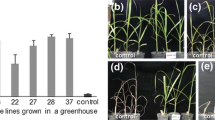Abstract
Cell suspensions derived fromSaccharum spp. varieties (PR62258, V64-10, V71-51) were used to study the effects of glyphosate on cell suspensions of commercial cultivars of sugarcane in order to select and develop a glyphosate-tolerant cellular line. A liquid medium with 0.8 mM/L glyphosate was used for selection. The results showed growth inhibition of approximately 50% for cell suspensions in mediums with 0.8 mM/L glyphosate. The results obtained in vitro were consistent with the results reported from in vivo tests. Plants were regenerated from sensitive cell suspensions and tolerant cell suspensions from cultivar V71-51. Tolerant cell suspensions tolerated a concentration that was 12.5-fold higher than that of the sensitive cell suspensions. Plants regenerated from tolerant cell suspensions tolerated a glyphosate concentration that was 6-fold higher than that of the plants regenerated from sensitive cell suspensions. Cell suspensions derived from tolerant regenerated plants tolerated a glyphosate concentration that was 5-fold higher than that of those derived from sensitive regenerated plants. The RAPD patterns obtained with OPA-07 revealed a 564-bp band that can be used to characterize the tolerant cellular line. This band is not present in the sensitive cellular line. Consequently, the tolerance persisted throughout the differentiation into plants and dedifferentiation into cell suspensions. This performance suggests that an in vitro selection of pre-existing variability has taken place.
Similar content being viewed by others
Abbreviations
- EPSP synthase:
-
5-enolpyruvyl-shikimate-3-phosphate synthase
- RAPD:
-
random amplification of polymorphic DNA
References
Chowdhury MKU and Vasil IK (1993) Molecular analysis of plants regenerated from embryogenic cultures of hybrid sugarcane cultivars (Saccharum spp). Theor Appl Genet 86: 181–188.
Duke SO (1987) Weed Physiology: Herbicide Physiology, pp 257. CRC Press, Florida.
Dyer WE, Weller SC, Bressan RA, and Herrmann KM (1988) Glyphosate tolerance in tobacco (Nicotiana tabacum L.). Plant Physiol 88: 661–666.
Eastman Kodak Company (1997) 1D Image Analysis Software, pp 230.
Harvey M and Botha FC (1996) Use of PCR-based methodologies for determination of DNA diversity betweenSaccharum varieties. Euphytica 89: 257–265.
Hoisington DA, Khairallah M, and González-de-León D (1994) Laboratory Protocols CIMMYT: Applied Molecular Genetics Laboratory. Second Edition, pp 51. CIMMYT, México.
Hughes K (1983) Selection for herbicide resistance. In: Handbook of Plant Cell Culture. Sharp WR, Ammirato PV, Yamada Y (eds), pp 442–460. Macmillan, New York.
Jones JD, Goldsbrough PB, and Weller SC (1996) Stability and expression of amplified EPSPS genes in glyphosate resistant tobacco cells and plantlets. Plant Cell Reports 15: 431–436.
Moore PH (1987) Breeding for stress resistance. In: Sugarcane Improvement Through Breeding. Heinz D (ed), pp 503–542. Elsevier, New York.
Murashige T and Skoog F (1962) A revised medium for rapid growth and bioassays with tobacco tissue cultures. Physiol Plantarum 15: 473–497.
Nafziger ED, Widholm JM, Steinrucken HC, and Killmer JL (1984) Selection and characterization of carrot cell line tolerant to glyphosate. Plant Physiol 76: 517–574.
Padgette SR, Kolacz KH, Delannay X, Re DB, LaVallee BJ, Tinius CN, Rhodes K, Otero YI, Barry GF, Eichholtz DA, and others (1995) Development, identification and characterization of glyphosate-tolerant soybean line. Crop Sci 35: 1451–1461.
Richard E (1991) Sensitivity of sugarcane (Saccharum sp.) to glyphosate. Weed Science 39: 73–77.
Sellin C, Forlani G, Dubois J, Nielsen E, and Vasseur J (1992) Glyphosate tolerance inCichorium intybus L. Var. Magbebourg. Plant Sci 85: 223–231.
Shenoy VB and Vasil IK (1992) Biochemical and molecular analysis of plants derived from embryogenic tissue cultures of napier grass (Pennisetum purpureum K. Schum). Theor Appl Genet 83: 947–955.
Singer SR and McDaniel CN (1985) Selection of glyphosate-tolerant tobacco calli and the expression of this tolerance in regenerated plants. Plant Physiol 78: 411–416.
Smart CC, Johanning D, Muller G, and Amrhein N (1985) Selective overproduction of 5-enol-pyruvylshikimic acid 3-phosphate synthase in plant cell culture which tolerates high doses of the herbicide glyphosate. J Biol Chem 260: 16338–16346.
Smith CM, Pratt D, and Thomspson GA (1986) Increased 5-enolpyruvylshikimic acid 3-phosphate synthase activity in a glyphosate-tolerant variant stain of tomato cells. Plant Cell Rep 5: 298–301.
Steinrucken HC, Schulz A, Amrhein N, Porter CA, and Fraley R (1986) Overproduction of 5-enolpyruvylshikimate-3-phosphate synthase in a glyphosate-tolerant Petunia hybrida cell line. Arch Biochem Biophys 244: 169–178.
Taylor PW, Ko JR, Fraser TA, Henry RJ, and Bircg RG (1995) Sensitivity of random amplified polymorphic DNA analysis to detect genetic chance in sugarcane during tissue culture. Theor Appl Genet 90: 169–1173.
Tingey SV and del Tufo JP (1993) Genetic analysis with random amplified polymorphic DNA markers. Plant Physiol 101: 349–352.
Vasil IK (1988) Progress in the regeneration and genetic manipulation of cereal crops. Bio/Technology 6: 397–402.
Vijayan N, Nair S, Screenivasan TV, and Mohan M (1999) Analysis of genetic diversity and phylogeny inSaccharum and related genera using RAPD markers. Genet Resour and Crop Evo 46: 73–79.
Williams JGK, Kubelik AR, Livak KJ, Rafalski JA, and Tingey SV (1990) Polymorphisms amplified by arbitrary primers are useful as genetic markers. Nucleic Acid Res 18: 6531–6535.
Williams JGK, Hanafey MK, Rafalski JA, and Tingey SV (1993) Genetic analysis using random amplified polymorphic AND markers. Meth Enzymol 218: 704–740.
Zambrano AY, Demey JR, and González V (1999) Selection of an Ametryn tolerant sugarcane cellular line. J Agr Univ P R 83: 47–54.
Zambrano AY, Demey JR, Fuchs M, González V, Rea R, Desousa O, and Gutiérrez Z (2003) Selection of sugarcane plants resistant to SCMV. Plant Sci 165(1): 221–225.
Author information
Authors and Affiliations
Rights and permissions
About this article
Cite this article
Zambrano, A.Y., Demey, J.R. & González, V. In vitro selection of a glyphosate-tolerant sugarcane cellular line. Plant Mol Biol Rep 21, 365–373 (2003). https://doi.org/10.1007/BF02772586
Published:
Issue Date:
DOI: https://doi.org/10.1007/BF02772586




